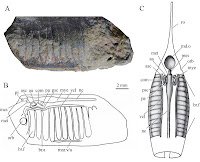Ray-finned
Fish, Actinopterygii, today comprise more than half of all living
vertebrate species, but their origins are somewhat obscure. Less than
20 species have been described from the Devonian and none from any
earlier deposits, and most of these Devonian Fish are described from
external moulds only, with the only two known species with good
internal preservation described from acid-prepared material the Gogo
Formation of Australia over 30 years ago.
In a paper
published in the Proceedings of the Royal Society Series B:Biological Sciences on 30 September 2015, Sam Giles of the Department ofEarth Sciences at the University of Oxford, Laurent Darras of
Noeux-les-Mines, Gaël
Clément of the Centre de Recherches sur la Paléobiodiversitéet les Paléoenvironnements
at Sorbonne Universités,
Alain Blieck ofLille University of Science and Technology and Matt Friedman, also of the Department of Earth Sciences
at the University of Oxford, describe a new species of Ray-finned
Fish from the Late Devonian Ferques Formation of Pas-de-Calais,
France.
The specimen
comprises an almost complete articulated skull within a block of
matrix material. Unlike the Gogo Formation material this was not
extracted with acid-preparation, but rather left within the block and
accessed by micro-computed tomography, with the hope that this could
preserve features of the material that might be lost to
acid-preparation.
The specimen
is described as Raynerius splendens, where 'Raynerius'
honours the late Dorothy Rayner for her work on the Fish of the Gogo
Formation, and 'splendens' means 'splendid', a reference to
the excellent preservation seen in the specimen.
Raynerius
splendens. (a) Rendering and (b) interpretive drawing of specimen
in left lateral view. (c) Rendering and (d ) interpretive drawing of
specimen in ventral view; skeletal elements interior to the dermal
bones (i.e. braincase, gill skeleton) shown in grey. Abbreviations:
a.on, aortic notch; av, accessory vomer; bb, basibranchial; cb,
ceratobranchial; chy, ceratohyal; clav, clavicle; clm, cleithrum;
cor, coronoid; dent, dentary; dhy, dermohyal; epi, epibranchial;
exsc, extrascapular; fr, frontal; gul, gular; hb, hypobranchial; hh,
hypohyal; hmd, hyomandibula; hmf, hyomandibular facet; ios,
interorbital septum; jug, jugal; l.gul, lateral gular; m.clav, median
clavicle; m.gul, median gular; mx, maxilla; na, nasal; op, operculum;
pa, parietal; por, postorbital process; prscl, presupracleithrum;
psp, parasphenoid; quj, quadratojugal; r.br, branchiostegal ray; scl,
supracleithrum; scl.r, sclerotic ring. Colour coding of the skeleton:
blue, cheek and jaw; purple, skull roof and sclerotic ossicle; pink,
braincase; dark green, hyomandibula; light green, operculogular
system; turquoise, shoulder girdle; yellow, gill skeleton. Giles et
al. (2015).
See also...
 Rhegmaspis xiphoidea: A streamlined Galeaspid Fish from the Early Devonian of Yunnan Province. Galeaspid Fish were jawless Bony
Fish distinguished by their heavily armoured head-shields with a median opening
which apparently served as a water intake and nostril, as was as complex
patterns of sensory...
Rhegmaspis xiphoidea: A streamlined Galeaspid Fish from the Early Devonian of Yunnan Province. Galeaspid Fish were jawless Bony
Fish distinguished by their heavily armoured head-shields with a median opening
which apparently served as a water intake and nostril, as was as complex
patterns of sensory... Gogoselachus lynnbeazleyae: The first recorded Shark from the Late Devonian Gogo Formation of Western Australia.
Gogoselachus lynnbeazleyae: The first recorded Shark from the Late Devonian Gogo Formation of Western Australia.
The
deepest evolutionary split in the jawed vertebrates (Gnathostomes) is
that between the Sharks (Chondrichthyes) and Bony Fish (Osteichthyes),
with all terrestrial vertebrates forming a subgroup within the...
Palaeontologists
have been interested in the endocasts of vertebrate skulls (moulds of
the interior of the skull made by sediment) since at least the
nineteenth century, due to the possibility that these can...
Follow
Sciency Thoughts on Facebook.


